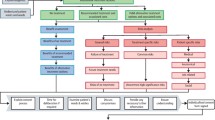Key Points
-
Consent is a process not a one-off event and the changing nature of a course of treatment must be communicated to the patient.
-
As part of obtaining consent, the patient must have adequate knowledge about the particular dental procedure they are invited to undergo.
-
Written consent is important but cannot be considered a substitute for obtaining valid consent.
Abstract
Consent is an integral part of delivering the care patients want. In order to consent to treatment, patients must have the legal capacity to give valid consent. If this three stage test is satisfied, the patient can elect to have any treatment they wish even if it is not in their best interest. Before a patient is able to consent to treatment they must have adequate knowledge about the risks, benefits and alternatives to the treatment. The amount of information provided to the patient by the dentist is determined to some degree by the legal system prevailing. The patient must voluntarily agree to treatment without being coerced by the dentist or other parties and if things change during treatment the patient needs to be advised. Written consent is very useful in the defence of cases but simply signing the consent form does not mean that the patient knows or understands the treatment to which they have agreed.
Similar content being viewed by others
Log in or create a free account to read this content
Gain free access to this article, as well as selected content from this journal and more on nature.com
or
References
General Dental Council. The first five years – a framework for undergraduate dental education. 2nd ed. London: General Dental Council, 2002.
Donabedian A. Evaluating the quality of medical care. Millbank Mem Fund Q 1966; 44(3) Suppl: 166–206.
General Dental Council. Principles of patient consent. London: General Dental Council, 2005.
Re MB (An adult: medical treatment) [1997] 2 FCR 541.
Re C (adult refusal of medical treatment) [1994] 1 All ER 819.
St George; Healthcare NHS Trust v S [1998] 2 FLR 728 at 739C.
Ms B v An NHS Hospital Trust [2002] 2 All ER 449.
D'Cruz L. Legal aspects of general dental practice. London: Churchill Livingston, 2006.
Sidaway v Board of Governors of the Bethlem Royal Hospital [1985] AC 871.
Hockton A. The law of consent to medical treatment. London: Sweet & Maxwell, 2002.
Bolam v Friern Hospital Management Committee [1957] 1 WLR 583; [1957] 1 BMLR.
Bolitho v City and Hackney Health Authority [1997] UKHL 46; [1998] AC 232; [1997] 4 All ER 771; [1997] 3 WLR 1151.
Rogers v Whitaker [1992] 175 CLR 479.
Pearce v United Bristol Healthcare NHS Trust [1998] E and WCA 2243.
Brands W G. The standard for the duty to inform patients about risks: from the responsible dentist to the reasonable patient. Br Dent J 2006; 201: 207–210.
Chester v Afshar [2004] UKHL 41; [2005] 1 AC 134; [2004] 3 WLR 927; [2004] 4 All ER 587.
Edwards A, Matthews E, Pill R, Bloor M . Communication about risk: the responses of primary care professionals to standardizing the 'language of risk' and communication tools. Fam Pract 1998; 15: 301–307.
Ernst S, Elliot T, Patel A et al. Consent to orthodontic treatment – is it working? Br Dent J 2007; 202: E25.
Department of Health. National Health Service (General Dental Services Contracts) Regulations 2005. Part 6, Schedule 3, Part 2, Paragraph 7(1). London: The Stationery Office, 2005.
Kennedy I, Grubb A . Medical law. 3rd ed. pp 753. London: Butterworths, 2000.
Doyal L. Informed consent: moral necessity or illusion? Qual Health Care 2001; 10 (Suppl 1): i29–i33.
Shaw D. Continuous consent and dignity in dentistry. Br Dent J 2007; 203: 569–571.
Byrne D J, Napier A, Cuschieri A . How informed is signed consent? Br Med J (Clin Res Ed) 1988; 296: 839–840.
Akkad A, Jackson C, Kenyon S, Dixon-Woods M, Taub N, Habiba M . Patients' perceptions of written consent: questionnaire study. BMJ 2006; 333: 528.
Department of Health. Reference guide to consent for examination or treatment. London: Department of Health, 2001. http://www.dh.gov.uk/prod_consum_dh/groups/dh_digitalassets/@dh/@en/documents/digitalasset/dh_4019079.pdf.
Admor Ltd. Treatment consent protocols. Details at http://www.admor.co.uk/index2.asp?url=content/products.asp?menu_id=46.
Author information
Authors and Affiliations
Corresponding author
Additional information
Refereed paper
Rights and permissions
About this article
Cite this article
D'Cruz, L. Risk management in clinical practice. Part 2. Getting to 'yes' – the matter of consent. Br Dent J 209, 69–72 (2010). https://doi.org/10.1038/sj.bdj.2010.627
Accepted:
Published:
Issue date:
DOI: https://doi.org/10.1038/sj.bdj.2010.627
This article is cited by
-
Risk management in clinical practice. Part 3. Crowns and bridges
British Dental Journal (2010)
-
Risk management in clinical practice. Part 6a. Identifying and avoiding medico-legal risks in complete denture prosthetics
British Dental Journal (2010)



